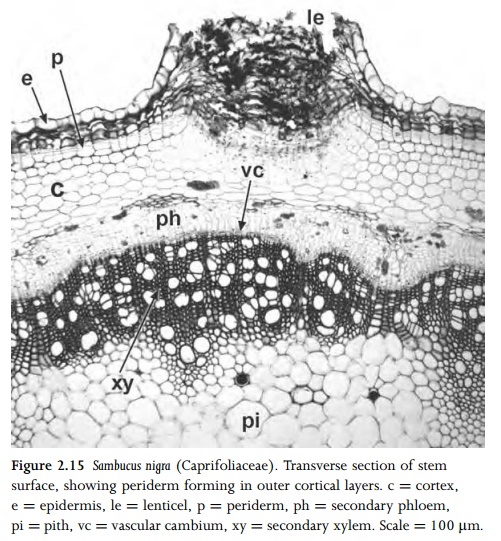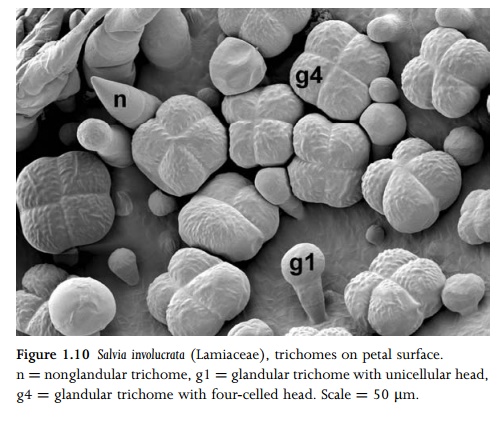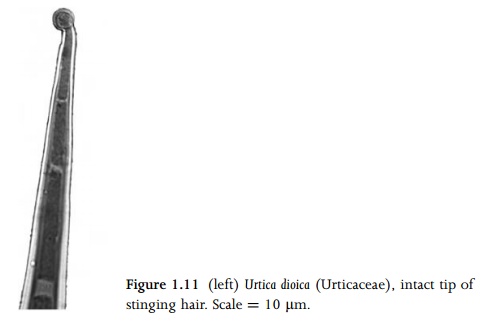Chapter: Anatomy of Flowering Plants: An Introduction to Structure and Development : Organs, Cells and Tissues
Plant Epidermis
Epidermis
The epidermis, the outermost (dermal) cell layer, is a complex tissue that covers the entire plant surface. The epidermis is a pri-mary tissue derived from the outermost layer of the apical meristem. It includes many specialized cell types, such as root hairs, stomata, trichomes and secretory tissues such as nectaries, both floral and extrafloral. The aerial plant surface is covered with a non-cellular cuticle and some-times with epicuticular waxes. Undifferentiated epidermal cells are termed pavement cells. In a developing plant the protodermal cells may give rise to trichomes, stomata or pavement cells, depending on their relative position. In Arabidopsis most stomata develop over the junction between underlying cortical or mesophyll cells, and most root hairs develop over the junction of hypodermal cells.
In growing organs, anticlinal divisions (at right angles to the surface) may occur in mature epidermal cells to accommodate stem or root thickening. In older stems and roots the epidermis often splits and peels away following an increase in thickness, and is replaced by a periderm (Fig. 2.15). In some roots the epidermis is worn away by friction with soil particles, and is replaced by an exodermis, which is formed by cell-wall thickening in the outer cortical layers.

Stomata
Stomata are specialized pores in the epidermis through which gaseous exchange (water release and carbon dioxide uptake) takes place. They occur on most plant surfaces above ground, especially on green photosynthetic stems and leaves, but also on floral parts. Each stoma consists of two guard cells surrounding a central pore (Fig. 1.9). Cuticular ridges extend over or under the pore from the outer or inner edges of the adjacent guard cell walls. Guard cells (Fig. 4.3) are either kidney-shaped (in most plants) or dumbbell-shaped (in Poaceae and Cyperaceae). Stomata

may be sunken or raised, and are often associated with a sub-stomatal cavity in the mesophyll, which is caused by differential expansion between the guard cell mother cell and the developing underlying mesophyll cells.
The epidermal cells immediately adjacent to the guard cells are termed subsidiary cells if they differ morphologically from surrounding epidermal cells. Classifications of stomatal types are based either on the arrangement of mature subsidiary cells, or on their patterns of development. Types of mature stomata include anomocytic, anisocytic, diacytic and paracytic124. Anomocytic stomata lack subsidiary cells entirely; anisocytic stomata possess three unequal subsidiary cells; diacytic stomata possess one or more pairs of subsidiary cells with their common walls at right angles to the guard cells; and paracytic stomata possess one ormore subsidiary cells at either side of the guard cells. However, different developmental pathways may lead to similar stomatal types, so this classification could group types that are non-homologous.
Ontogenetic stomatal types include agenous, mesogenous and perigenous85,112. During development, a protodermal cell under-goes an unequal mitotic division to produce a larger daughter cell and a meristemoid (guard cell mother cell). In the agenous devel-opmental type the meristemoids give rise directly to the guard cells, and there are no subsidiary cells. In the perigenous type, the meristemoid gives rise directly to the guard cells, and subsidiary cells are formed from neighbouring cells, often by oblique divi-sions. In the mesogenous developmental type the guard cells and subsidiary cells have a common origin; the meristemoid under-goes a further mitotic division into two cells, of which one further subdivides to form the guard cells, and the other usually forms one or more subsidiary cells. In mesoperigenous stomatal complexes the guard cells and subsidiary cells are of mixed origin. Subsidiary cells derived from the meristemoid are termed mesogene cells, whereas those derived from neighbouring cells are termed perigene cells, though in some cases mesogene cells are not distinct from surrounding epidermal cells at maturity.
Trichomes
Trichomes are epidermal outgrowths that occur on all parts of the plant surface (Fig. 1.10). They vary widely in both form and function, and include unicellular or multicellular, branched or unbranched forms, and also scales, glandular (secretory) hairs, hooked hairs and stinging hairs. Papillae are generally smaller than trichomes and unicellular, though the distinction is not always clear. In cases where there are several small outgrowths on each epidermal cell, these outgrowths are termed papillae, but where there is only one unicellular outgrowth per cell, the distinction is dependent on size.

Glandular trichomes usually possess a unicellular or multi-cellular stalk and a secretory head with one to several cells. Secreted substances such as volatile oils collect between the secretory cells and a raised cuticle, which later breaks to release them. There are many different types of glandular hair, and they secrete a variety of substances, including essential oils and salt; some carnivorous plants’ digestive juices contain proteolytic enzymes31. Leaf glandular hairs of Cannabis sativa secrete a resinous substance containing the mild hallucinogen tetrahydrocannabinol. Glandular hairs of Drosophyllum and Drosera secrete both sticky mucilage and proteolytic enzymes. The stinging hairs of Urtica dioica (stinging nettle) are rigid, hollow structures that contain a poisonous substance (Fig. 1.11). The spherical tip of the hair is readily broken off in contact with an outside body, and the remaining sharp point may then penetrate the skin and release

Related Topics